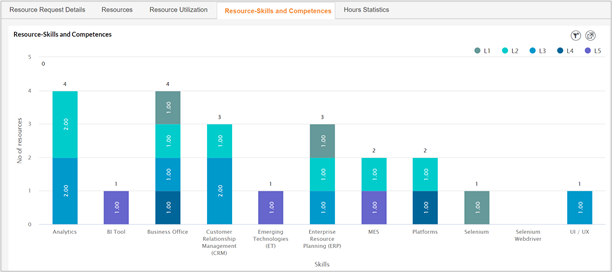Organizations deal with products and services that drive their revenue and profitability.
But it is your people that understand, visualize, design, develop, and implement products and services to the customers of any business enterprise.
It is a no-brainer that senior leaders must give the maximum focus and attention to resource management. However, as organizations grow both locally and globally, effective and efficient resource management hinges on the adoption of the appropriate resource management system or resource management software.
Let us focus on the ten biggest resource management challenges as well as their potential solutions.
RESOURCE MANAGEMENT CHALLENGES
#1. POOR BUSINESS DEMAND VS. RESOURCE CAPACITY MANAGEMENT
Organizational growth is good news – if growth is managed well. It is no longer a secret that organizations struggle with ‘bench resources!’
Imagine an organization with even ten thousand employees and with even 5% bench resources – this translates to two thousand five hundred employees getting paid for ‘doing nothing.’
Depending on the geography, it is not hard to assess the cost of such benched resources and their drain on the bottom line.
Such excess resources are a by-product of poor mapping of incoming business demand with resource capacity management.
How could Resource Management Software be of value?
Effective resource management begins by connecting business demand with resource availability.
A strong resource capacity planning software offers visibility to resource managers about the number of projects in the pipeline as well as the number of resources needed along with their competencies and skills.
Based on this input, resource managers can proactively manage existing resources and trigger additional hiring resources.

#2. LACK OF ACCESS TO AN ORGANIZATIONAL/BUSINESS UNIT RESOURCE POOL
Organizations rely on people with a diverse set of skills that are geographically dispersed. There are multiple HR/Resource Managers at each of these locations responsible for resource management.
Most of these HR/Resource Managers rely on standalone Spreadsheets or emails to manage resources. The result is quite as expected – delays, inefficiencies, inaccuracies, resource request vs. assignment mismatch, under/over utilization of resources, etc.
The impact – increased project durations, lower quality delivery, customer dissatisfaction, lost recurring businesses, etc.
How could Resource Management Software be of value?
Today’s resource management software offer capabilities to create and manage a centralized resource pool that offers business leaders and PMOs complete visibility into the available resources.
With appropriate access rights, PMOs, Resource Managers, and Project Managers can match their project requirements with the resources from the resource pool.
Necessary triggers to hire resources or scale down resources enable the senior management to optimize resource management costs.
#3. LACK OF VISIBILITY INTO RESOURCE SKILLS & COMPETENCIES
Projects and programs require unique skills, competencies, and experiences. Getting this level of detail from a medium (500 to 5000 employees) to a large organization (over 5000 employees) is a herculean task, not to forget the time needed to get the ‘right resource’ for the project.
How could Resource Management Software be of value?
Top-class resource management systems come equipped with the ability to capture resource skills, competencies, experience, location, cost profile, time zone, and other parameters that make resource management like child’s play!
Remember that your project costs are tightly linked with your resource profile.

#4. AD HOC AND MANUAL RESOURCE REQUEST & ALLOCATION
Depending on the size of the organization as well as the importance of the projects undertaken, resources are allocated based on multiple levels of scrutiny and approval.
Unfortunately, most organizations struggle with ad hoc and mostly manual/email-based approaches to resource requests and approval.
The situation gets aggravated when resources are shared on multiple projects – the time taken to allocate resources gets unduly long and unpredictable.
How could Resource Management Software be of value?
A resource management system can define project-specific workflows for resource requests, review, approval, and resource allocation.
Rule-based notifications can be defined based on the various stages of the resource request and allocation process.
#5. UNABLE TO ‘SOFT BOOK’ (TENTATIVE) RESOURCES
The sales and business development teams pursue numerous at the same time hoping that some of them would materialize.
The potential deals move through different stages – cold, warm, and hot, indicating low-to-high levels of winning probability. As deals move towards the ‘hot’ category, senior managers would like to ‘block’ specific resources in a ‘tentative’ manner.
The idea is to deploy these resources when the deal is won. However, the cost of such ‘soft-booked’ resources does not get absorbed immediately.
Such a mechanism offers flexibility to senior managers to identify and reserve certain key resources when the project becomes a reality.
This is a big challenge for both the sales as well as the project delivery teams.
How could Resource Management Software be of value?
A resource management system offers managers the flexibility to allocate resources either as (a) soft or tentative booking and (b) hard or committed booking.
Mechanisms exist in resource management systems to convert soft booking too hard booking. Alerts get triggered to Requestors to let them know that either they release soft-booked resources or accept the cost of such resources.
#6. INEFFECTIVE RESOURCE UTILIZATION ASSESSMENT
Senior business executives want to ensure resources are optimally utilized – closer to 100% is ideal! A common challenge is where one set of resources is burning the midnight oil while another set is teeing away to glory – an indication of skewed resource utilization.
If your total resources cost is USD 1 million and if your resource utilization is 70%, then you are staring at 300K USD of wasted costs – imagine the impact on your bottom line!
How could Resource Management Software be of value?
A resource management system dynamically captures the resource utilization levels in real-time based on the resource allocation made across the entire portfolio of projects that are undertaken by an organization – in an integrated manner, so that project managers, sponsors, and senior management have perfect visibility and relevant resource-related decisions could be taken.
#7. UNIDENTIFIABLE RESOURCE EFFICIENCY
Comparing planned effort vis-à-vis actual effort expended by resources – an indication of the quality of estimation as well as resource efficiency.
Resource efficiency can trigger coaching, training, and role change as well. Above all, tracking actual effort is critical for accurate and 100% client billing – when your customer pays based on a T&M basis.
How could Resource Management Software be of value?
A resource management software comes with capabilities to –
- Create a very granular work breakdown structure
- Assign tasks to a specific resource(s)
- Capture planned effort/duration
- Capture actual effort/duration including overtime, weekend time, etc.
Resource managers and PMOs can be successful in two ways – estimation of future projects and providing accurate inputs to client invoicing.
#8. MISSING RESOURCE PRODUCTIVITY VIEW
A big challenge for organizations is to capture and analyze work, both productive and non-productive. Systems don’t exist to classify work categories – those that add value and those that don’t! Higher levels of non-value-adding work are a costly drain on the company’s financials.
More importantly, when expert and high-cost resources end up doing non-value-adding work, the impact on the business is significant.
How could Resource Management Software be of value?
With a resource management system, organizations can create different categories of work and classify them as either value-adding or non-value-adding.
Subsequently, leaders can easily analyze the percentage of work that is non-value adding and take suitable remedial measures.
#9. MULTIPLE DATA VERSIONS
Another key challenge is that organizations invariably have multiple and disparate systems, typically ERPs, HRMS, CRMS, Accounting, and others.
When these systems are ‘not integrated’, managers and decision-makers struggle with data accuracy and integrity – putting a heavy price on the confidence and the quality of the decisions made.
How could Resource Management Software be of value?
Today’s top-class resource management system can seamlessly integrate resource-related information across multiple enterprise applications and ensure data integrity.
Senior leaders can safely rely on ‘one version of resource truth’ and be confident in their decisions.
#10. ANALYTICS
Analytics represent insights that are shortcuts to quick and effective decisions. Living in a world of data explosion, Senior leaders, Resource Managers, and PMOs need access to resource analytics that facilitate swift decisions.
Yet, organizations continue to rely on traditional spreadsheets and presentation software for data analysis and their graphical representation – instead of focusing on business value!
How could Resource Management Software be of value?
A resource management software can combine different elements of resource management based on the nature of work undertaken and offers multiple slice-and-dice of information that matter to businesses.
FOOD FOR THOUGHT FOR DECISION-MAKERS
Your resource management software can deliver business value in many ways including –
- Strategic resource management
- Digitized resourcing landscape
- Controlled resource allocation & tracking
- Timely effort tracking and 100% accurate client billing
- Higher project profitability and ROI





